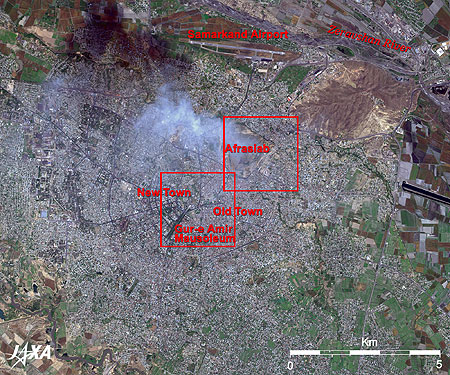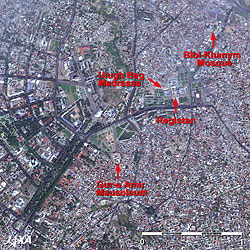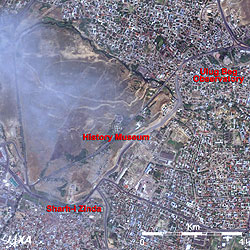Seen from Space 2007
Samarkand, Uzbekistan- "The Blue City"/"The Gem of The East" once-flourishing on the Silk Road
The eastern area of the city is the old city where many historical heritages remain, and the western area is the new city developed by city planning during the Soviet era. A geometrically ordered city structure in the left half of the city can be seen from the figure. In old times, it was called Marakanda of Sogdian and was developed through trading since about the 10th century B.C. as one of the most important oasis cities on the Silk Road. It was called the "Crossroads of Cultures" and was always most noted for and prospered from its central position on the Silk Road. However, in 1220, Genghis Khan destroyed the town built on the hill of Afrasiab, burning it to ashes. It was hero Timur the Lame (1336-1405) who revived Samarkand. He collected art at that time and architectural skills as soon as he made Samarkand the capital of the empire and revived it as a remarkable city in the Islamic world. The Gur-e Amir Mausoleum is located in the middle of the city. Timur built this mausoleum for his grandson but with time, it became the king's mausoleum of the Timurid dynasty including himself.
Today's Samarkand centers on Registan Square, and many historical landmarks that recall old times are concentrated around the square. Three huge madrassas (Islamic seminary) surrounding the square are visible. They are, from right to left, Sherdar Madrassa with decorations featuring a roaring lion; Tilla-Kari Madrassa, which boasts gilded decorations on the inner wall of the blue dome; and Ulugh Beg Madrassa built by astronomer Ulugh Beg, the grandson of Timur. Bibi-Khanym Mosque is located on the northeast of the square. Bibi-Khanym is said to be the name of Timur's wife, and this grand mosque was constructed in 1404. This was once the largest mosque in the Islamic world. To its east, the brownish area, partially covered by clouds in Fig. 3, is the hill of Afrasiab, i.e. the ruins of ancient Samarkand. Shah-i Zinda complex on the south foot of the Afrasiab hill is a vast necropolis of the Timurid dynasty related people. This is a sacred place for Muslims, and the variety of decorations and beauty of those mausoleums with domes is said to be the greatest in Central Asia. The most brilliant finding among the archeological excavations was the Sogdian frescos in the 7th century, and they are exhibited in the Afrasiab Museum located on the southeastern limb of the hill. The portraits of the Sogdian traders, an envoy from a foreign country having an audience with the king, and the life of people. are vividly drawn with great reality. Ulug Bek Observatory is visible to the east of Afrasiab hill. Ulug Bek was a grandson of Timur and the 4th sovereign ruler of the empire. He was quite skilled in politics and diplomacy, and he was an exceptional administrator having a deep understanding for various cultures and spared no effort to support them. At the same time, he was a scientist as well as a ruler, and he was one of the top ten renowned astronomers of the world at that time. It is said that this was the place where he observed stars with a huge (40m high and 63m long) sextant, surrounded by a dome of three stories. Based on the observations here, he determined the length of one year with an astonishing accuracy less than one minute. "Samarkand- Crossroads of Cultures" was added to the list of the World Heritage of the United Nations Educational, Scientific and Cultural Organization (UNESCO) in 2001.
|







